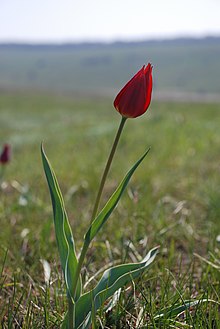Tulipa schrenkii
| Tulipa schrenkii | |
|---|---|
 |
|
| Scientific classification | |
| Kingdom: | Plantae |
| (unranked): | Angiosperms |
| (unranked): | Monocots |
| Order: | Liliales |
| Family: | Liliaceae |
| Genus: | Tulipa |
| Species: | T. schrenkii |
| Binomial name | |
|
Tulipa schrenckii Regel |
|
| Synonyms | |
|
Tulipa suaveolens Roth, Tulipa volgensis M.Bieb. ex Eichw., Tulipa hortulanorum Wender., Tulipa odoratissima Vis., Tulipa oxypetala Steven, Tulipa schrenckii var. bicolor Regel, Tulipa schrenckii var. pluriflora Regel, Tulipa turcarum Levier, Tulipa gesneriana var. acutiflora, Tulipa gesneriana subsp. schrenkii (Regel) Nyman, Tulipa monticola E.Wulff, Tulipa splendens Delip. |
|
Tulipa suaveolens Roth, Tulipa volgensis M.Bieb. ex Eichw., Tulipa hortulanorum Wender., Tulipa odoratissima Vis., Tulipa oxypetala Steven, Tulipa schrenckii var. bicolor Regel, Tulipa schrenckii var. pluriflora Regel, Tulipa turcarum Levier, Tulipa gesneriana var. acutiflora, Tulipa gesneriana subsp. schrenkii (Regel) Nyman, Tulipa monticola E.Wulff, Tulipa splendens Delip.
Tulipa schrenkii or Tulipa suaveolens, Schrenck's tulip, is a bulbous herbaceous perennial of species of tulip (Tulipa) in the family of the Liliaceae. It belongs to the section tulipa.
The tunic of the bulb is dark brown. Stiff hairs grow on the inside, especially towards the tip. The 3-4 leaves are glaucous and undulate. They are normally 10, sometimes up to 20 cm long and 3–6 cm wide. The stem is 15–30 cm long and glabrous, sometimes slightly hairy. The flowers of Tulipa schrenckii are bowl shaped and very varied in colour. They can be red, light-red, pink, mauve, yellow or white. There are also forms with red petals bordered in yellow or white
Tulipa schrenckii inhabit the Eurasian steppe : the southern and eastern Ukraine, the Crimea, the European part of Russia, especially on the lower Don, around the Sea of Azov, and major part of Ciscaucasia (in south until North-Ossetia, Kabardino-Balkaria and in the former Chechen-Ingush region, Terek, northern Dagestan), in the south-east of Voronezh Oblast, major part of Volgograd Oblast and Saratov Oblast, southern Samara Oblast, Orenburg Oblast, western and northern Kazakhstan, and the lowlands of western Siberia, Central Asia and China. It is also announced localy in western Iran and Azerbaijan.
...
Wikipedia
